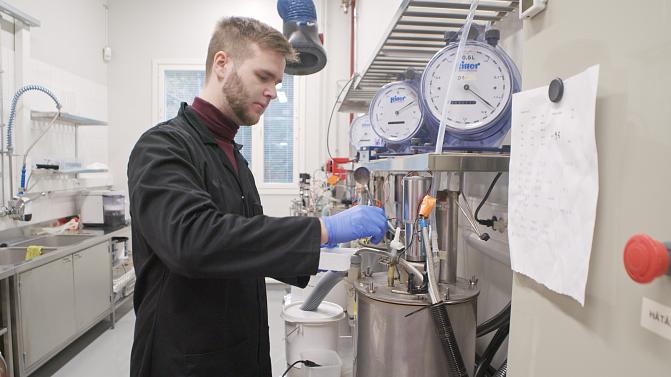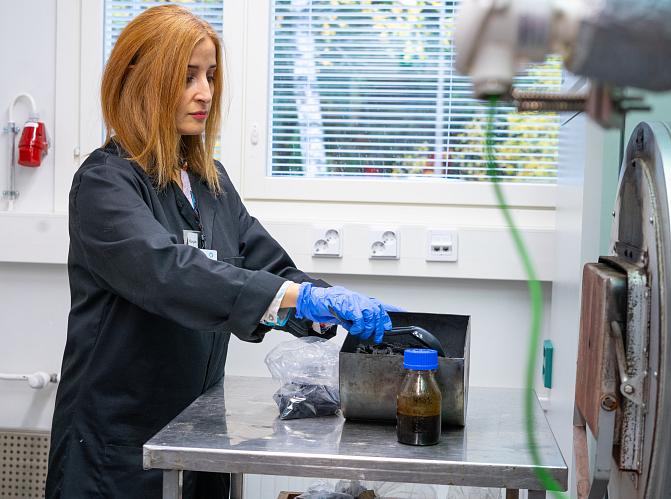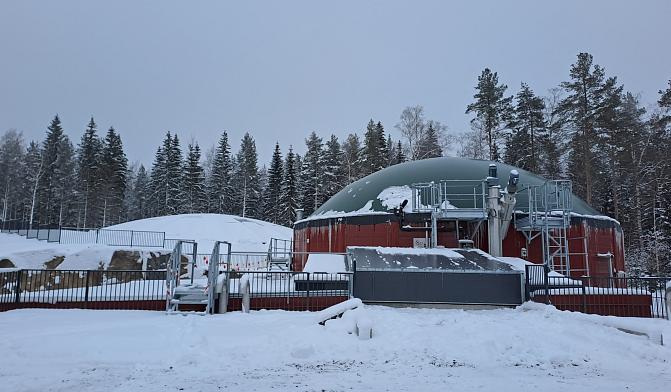
Biopaja – solutions for the circular bioeconomy
On this page
Biopaja is Luke’s experimental facility in Jokioinen. In Biopaja, various solutions can be tested to study and demonstrate the nutrient and organic matter recycling of different biomasses. Luke works with and serves companies in developing and adopting recycled fertilisers, renewable energy and other value-added products.
Benefits for clients
In Biopaja, the processing of biomasses into new valuable products by means of biogas, pyrolysis and nutrient recovery technologies, can be demonstrated in laboratory and pilot scale. Furthermore, Biopaja enables the assessment of varying processing chains and the production of multiple products from various biomasses and side streams. By cascading use of processing technologies, we can enhance the use of biomasses to get the most value out of them. Experiments on a laboratory and pilot scale ensure the effectiveness of processes and reduce investment risks.
Services
Biopaja services are customised according to the specific needs of each customer. Examples of our services:
- Biogas production research
- Manufacturing and utilisation experiments for bio-based fertilisers
- Pyrolysis experiments and research of pyrolysis products
- Regional/local biomass potential assessments
- Laboratory analytics
- Techno-economic assessments
We provide customised studies and consultation in accordance with customer-specific needs. We conduct research and development projects in cooperation with universities, research institutions and companies.
Biogas production research
Biopaja’s research facilities and expertise enable comprehensive research and development of biogas production. For example, new feedstock options and feedstock ratios, as well as the impact of operating conditions can be studied, ranging from the determination of the methane production potential to piloting and farm scale anaerobic digestion.
Full-scale biogas processes can be simulated in laboratory-scale through long-term tests to study process behaviour. On a laboratory scale, any disruptions and problems can be identified quickly, which enables the cost-efficient and safe testing of new feedstocks and operating conditions.
In addition to biogas production, the facilities can be used in research and development of organic acid and biohydrogen production. The research facilities also enables two-phase processing where the first phase operates as pre-treatment or as producing organic acids/biohydrogen, and the second phase operates as conventional biogas reactor.
Equipment
- Biomethane potential test system for up to 40 samples
- Continuous stirred tank reactors that can be fed using solid or liquid feedstocks, with the dry matter content in the reactor remaining below 15%
- Plug-flow reactor for examining the progress of process during different stages with three measurement points
- Laboratory and pilot scale leach-bed reactor for dry feedstocks, including grass, straw and dry manure (or a mixture).


Manufacturing and utilisation research for bio-based fertilisers
Biopaja’s facilities offer various opportunities for developing bio-based fertilisers. Several processing technologies are available for different biomasses.
From biomasses with high water content (e.g., liquids after solid-liquid separation), liquid fertiliser products can be concentrated. Drier biomasses can be used to develop fertiliser products suitable for conventional fertiliser spreaders using granulation and pelletising equipment.
The nutrient content and physical properties of bio-based fertiliser products can be tailored by adjusting process parameters or by adding organic or mineral fertiliser components to the raw material mix.
Examples of services for the tested biomasses and bio-based fertilisers
- Main and micro-nutrient content
- Ash and carbon content
- Bulk density (loose and tapped)
- Strength, size distribution, flowability. Dust content and storage durability of granular fertilisers
We offer the opportunity to compare results with benchmarking data concerning bio-based fertilisers available in national and international markets.
In addition to fertiliser product development, we conduct fertilisation experiments and demonstrations on various scales to verify the impact of fertilisers on yields and environment, and their spreading capacity.
Pyrolysis experiments and research
Pyrolysis process converts biomass to gas, liquid and solid biochar fractions.
Luke’s laboratories are equipped to test the applicability of various biomasses in the pyrolysis process. We offer comprehensive services to analyse the quality of end-products and to test their performance in various applications. Our expertise covers range of biochar and pyrolysis liquid fraction applications for agriculture, forestry and related industry.
Examples of services
- Chemical and physical properties of pyrolysis products
- Investigation of the stability and agronomic performance of biochar in soil applications
- Suitability of various biochar products for growing media and soil improvement (e.g. water retention capacity, and laboratory, greenhouse and field experiments)
- Technical use and new innovative applications of biochar and pyrolysis liquids


Biomass potential research and assessments
The starting point for profitable biomass-based business is mapping the biomass availability. Luke provides Biomass Atlas service for open use but more precise estimations can be done as customer work as well as planning the logistic chains. Luke has a holistic understanding of biomass value chains covering biomass production, harvesting and transportation, biogas processing and nutrient recycling. We have conducted various studies of the availability of agricultural, municipal and industrial waste and side-streams, especially related to biogas production.
Examples of services
- Biomass Atlas for open use
- Biomass feedstock availability and logistic studies for digestion plants to produce biogas and fertiliser products
- Investigations of transportation and spreading potential of recycled fertiliser products, considering field properties
Tools developed at Luke (Biomass Atlas, Nutrient Calculator), supplemented with calculation systems and biomass property database, are utilised to assess the phosphorus and nitrogen content, as well as the methane production potential of various biomasses.
Techno-economic analyses
In techno-economic analyses, a value chain is built around the core process. Even though processing generates additional costs, it can produce significant savings in logistics costs or increase the value of the end product.
Baseline data is collected together with the client. The next step is to see what products can be brought on the market and at what price. After this, unit processes are selected following the cascade processing principle in which the highest added-value use is prioritised and the processing continuously adds value to the intermediate products.
A techno-economic analysis is conducted at each stage of the value chain. These typically include raw material procurement, storage, processing, distribution, and use. The economic profitability is evaluated by calculating investment and operating costs and income, as well as the investment’s payback time and profit.
Luke has developed the Biogas Tool, available online, for evaluating the profitability of biogas production. In addition, more detailed profitability evaluations are conducted for biogas investments based on customer assignments.
Market potential analyses can also be conducted for completely new types of products through surveys.
Laboratory analytics
Biopaja’s research activities are supported by Luke’s extensive experience in analytics and comprehensive analysis methods of Luke’s laboratories. Chemical analyses can be conducted for various biodegradable matrices, monitoring samples from biogas processes and, for example, gaseous samples obtained from biogas plants. Microbiological determinations are also integral part of our expertise.
Bio-based fertiliser analytics cover nutrient analyses for fertiliser products (e.g. digested, composted and processed products), properties of granular and pelletised products, and agronomic performance. Analysis packages can be tailored according to customer-specific needs.
Farm-scale biogas plant
A farm-scale biogas plant was built in conjunction to the Luke Jokioinen research barn. Together with Luke's Biopaja research facility, the new biogas plant will enable a wide range of research, development and customer projects.
Photo: Sari Luostarinen
The plant’s feedstocks are dairy cattle slurry from the research barn, plant biomass and solid manure. The biogas produced can be used either in a 50 kW CHP unit or in a 150 kW boiler. The energy produced (approx. 1150 MWh/year) is used as heat and electricity in the local energy grid of the Jokioinen livestock research infrastructure.
The digestate produced can be separated into liquid and solid fractions using a screw separator or a decanter centrifuge. The solid fraction is used either as a bedding material or as a fertiliser. The liquid fraction is used as a fertiliser on Luke's research fields.
The biogas plant is equipped for research purposes offering the possibility to study, for example, the effects of different feedstocks and digestate processing.


Videos
Allow functional cookies to show the embedded media.
Allow functional cookies to show the embedded media.



